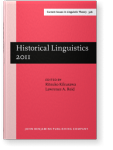The historical development and functional characteristics of the go-adjective sequence in English
This paper explores the historical development and functional characteristics of the go-adjective sequence in English, relying upon two corpora. The go-adjective sequence has two groups, the change-of-state and the state groups. The change-of-state group is divided into two types. The first type expresses an involuntary change of state. With respect to its historical development, there is a possibility that the adjectives will be replaced by new forms in the future. The second type expresses a voluntary change of state. It is possible to pinpoint incipient development. Similarly, the state group is further divided into two types. The first type expresses a state only. The second type not only expresses a state, but also signals the modal notion of counter-normativity. This second type is currently undergoing a change. This paper demonstrates a corpus-based approach as a means of identifying characteristics underlying the go-adjective sequence, which might otherwise remain unexplained.
